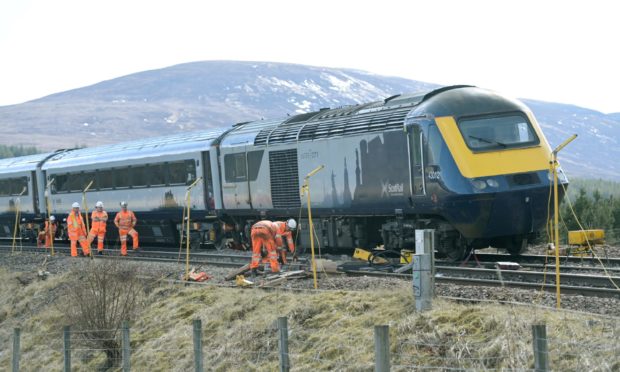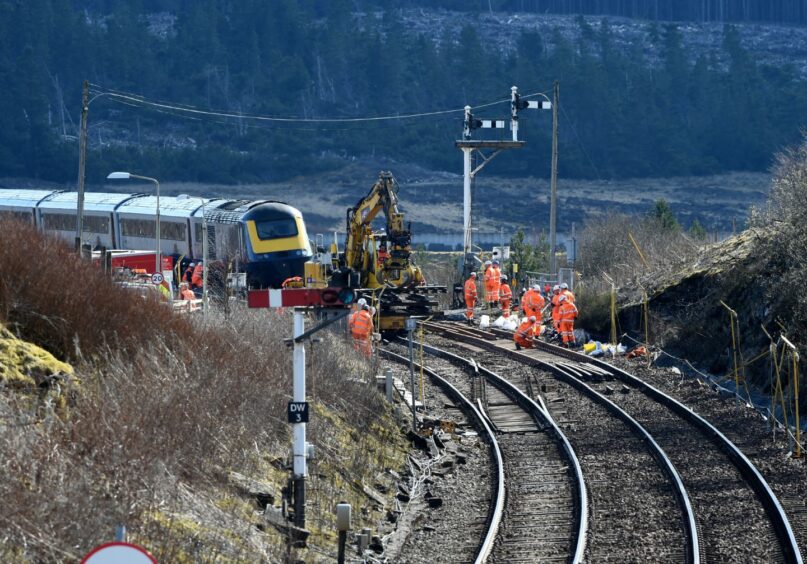Investigators found a train derailed near Dalwhinnie station last year due to a signalling failure caused by a wiring error.
The empty coaching stock train was derailed near the Highland station shortly after 3am on April 10, 2021.
It was being used for testing, including examining the stepping distances from the train doors to the platforms and the length of the train.
No one was injured during the incident.
Wiring error in signalling system
Rail Accident Investigation Branch (RAIB) found the train was wrongly diverted because of a wiring error in the signalling failure.
The system had been introduced when the point machine at the trailing end was replaced around nine months earlier.
Investigators found the front of the train was directed over the crossover and then trailed through and forced apart the points at the trailing end.
However, the signalling system only then detected the points were not correctly set and automatically re-sent a command for both point ends to move to the position that the signaller had earlier commanded.
This caused the points at the facing end to move under the train, which derailed the rear of the carriage when it passed over them.
Lack of clarity
The need to alter the internal wiring was not identified when the renewal work was planned.
The point machine was tested and commissioned following processes that Network Rail prescribes for signalling maintenance work when installing a like-for-like replacement.
The last opportunity to identify the wiring error before the points were handed back into service was an out-of-correspondence test.
However, the specified testing work was interrupted by the need to wait for the signaller to arrive at the signal box. As a result, this and other outstanding testing work was overlooked, the tester in charge believing that it had already been completed.
RAIB found a lack of clarity in Network Rail’s signalling maintenance standards concerning the working arrangements of the appointed tester and of those carrying out this type of like-for-like installation work.
Investigators have recommended Network Rail define the tasks and responsibilities of its signalling maintenance teams when carrying out pre-planned like-for-like equipment replacement work.
The company should provide information and warnings for replaceable items of signalling equipment, and the effectiveness of pre-installation checks.
Additionally, arrangements should be made for recording the progress and findings of signal maintenance testing.
‘Dalwhinnie needs to act as another salutary reminder to the industry’
Andrew Hall, chief inspector of Rail Accidents explained the causes of the accident at Dalwhinnie bear an “alarming similarity” to those found in the multi-fatal accident at Clapham Junction in 1988.
The accident is also similar to the more recent collision at Waterloo in 2017, which caused huge disruption on routes into London.
He said: “These accidents share a common theme, that an undetected wiring error resulted in the failure of the signalling system. At Dalwhinnie, this meant that the signalling system did not detect that some points were in an unsafe position, resulting in the derailment of a train.
“Thankfully no one was injured. However, the train could have been carrying passengers and travelling at a much higher speed, and the outcome very different.”
Mr Hall said waiting within a signalling system is “safety critical” and needs to be checked careful and tested when engineering work is carried out.
He finished: “Those who don’t remember the past are condemned to repeat it, has been said in many ways by many people. When it comes to fully understanding the importance of hard-learned lessons around the wiring of railway signalling, the accident at Dalwhinnie needs to act as another salutary reminder to the industry.”


